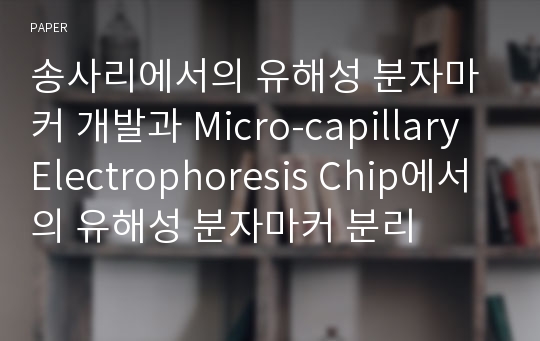송사리에서의 유해성 분자마커 개발과 Micro-capillary Electrophoresis Chip에서의 유해성 분자마커 분리
*정*
다운로드
장바구니
소개글
본 연구의 목적은 유해 환경오염물질인 유기인산계 농약(Diazinon)에 노출된 모델 생물체(송사리)의 비정상적인 행동과 형태적 변화가 일어나는 100ppb의 농도에서 분자생물학적인 방법을 이용하여 transcription 수준에서의 이상발현을 통해 생물지표(biomarker)를 개발하는데 있다. 이러한 이상행동과 형태적 변화와 연계된 차별 발현된 유전자의 발현 분석을 통하여 적절한 생물지표를 동정, 검증하고자 하였다.또한, 랩온어칩의 플랫폼 기술의 생물학적 환경 모니터링에 응용하기 위해 PDMS 기반의 micro-capillary electrophoresis (MCE) chip을 제작하였다. 이 칩은 Photo공정을 통해 negative 감광제(SU-8)로 mold를 제작한 후 PDMS를 열경화시키고, O2 plasma로 표면처리하여 접합시켰다. Biomarker로써 발현양의 차이가 가장 큰 ribosomal protein S17을 PDMS기반의 MCE chip에서 미세관을 통해 분리 실험을 하였다. 랩온어칩의 다양한 장점과 유용성을 고려할 때 환경 시료의 분석, 환경 독성 분석, 환경 미생물 분석 분야에 칩, 센서 기술이 광범위하게 적용될 수 있어 유해성 생물지표 개발에 랩온어칩의 적용은 환경 모니터링을 위한 의미있는 시도라고 사료된다.
목차
Ⅰ. INTRODUCTIONⅡ. THEORETICAL BACKGROUND
2.1 Biomarker
2.2 Ecotoxicogenomics
2.2.1 Historical and current perspectives in fish toxicology
2.3 Model Organism
2.4 Hazardous Toxic Chemicals
2.5 Lab-on-a chip
2.6 Plasma Treatments in Surface Chemistry
2.7 Electrophoresis
Ⅲ. MATERIALS AND METHODS
3.1 Experimental Fish and Chemical
3.2 Total RNA Extraction
3.3 Annealing Control Primer RT-PCR (ACP RT-PCR)
3.4 Cloning and Analysis of cDNA
3.5 Annealing Control Primer RACE PCR for getting Full-length cDNA
3.6 Phylogenetic Analysis
3.7 Real Time qPCR Analysis
3.8 Statistical Analysis
3.9 Fabrication of Micro-Capillary Electrophoresis (MCE) Chip
3.9.1 Mask design for forming pattern of MCE chip
3.9.2 Fabrication process of PDMS-based MCE chip
3.9.3 Bonding of PDMS/glass or PDMS/PDMS
3.9.4 Measurements of Contact Angle
3.10 Separation and Instrumentation
Ⅳ. RESULT AND DISCUSSION
4.1 Differential expressed genes in medaka
4.2 Analysis of Gene Ontology
4.3 Isolation of Full-length cDNA
4.4 Phylogenetic Analysis
4.5 Analysis of Real-Time Quantitative PCR
4.6 Ribosomal Protein Cording Genes and Various DEGs
4.7 Fabrication and Characteristics of PDMS-based MCE chip
4.8 Separation of Ribosomal Protein S17 gene on MCE chip
Ⅴ. CONCLUSION
Ⅵ. ACKNOWLEDGEMENTS
Ⅶ. LITERATURE CITED
본문내용
환경모니터링과 환경질의 개선에 유용한 도구로 활용되는 환경 독성평가는 오늘날 환경문제의 접근에 있어서 많은 발전을 거듭해 왔다. 이전의 전형적 분석방법은 고비용과 낮은 신뢰도 그리고 화학적 분석법의 단점인 독성반응과 생체이용률(bioavailability)의 복합적인 예측의 불가능으로 진보된 분자생물학적 기법의 적용이 점차적으로 필요하게 되었다. 생태학적 유해성은 유해성(hazard) 측면에 있어서 특정한 화학물질과 혼합된 화학물질의 노출(exposure)과 동등하게 적용되어야 하며, 화학물질의 노출과 유해성의 폭넓은 측정은 생물학적 시스템을 이용한 독성평가에 의하여 그 목적을 달성할 수 있다. 이러한 유해성 평가에 있어서 환경오염물질의 영향을 효과적으로 알기 위해 분자마커를 이용한 독성분석 방법이 개발되었다. 그러나 생물모델을 이용한 다양한 환경 유해성 biomarker의 개발이 충분하게 진행되지 않아서, 환경오염물질이 생물체에 미치는 영향을 정확히 평가할 수 있을 다양한 종류의 분자마커 개발 연구가 요구되고 있다.본 연구의 목적은 유해 환경오염물질인 유기인산계 농약(Diazinon)에 노출된 모델 생물체(송사리)의 비정상적인 행동과 형태적 변화가 일어나는 100ppb의 농도에서 분자생물학적인 방법을 이용하여 transcription 수준에서의 이상발현을 통해 생물지표(biomarker)를 개발하는데 있다. 이러한 이상행동과 형태적 변화와 연계된 차별 발현된 유전자의 발현 분석을 통하여 적절한 생물지표를 동정, 검증하고자 하였다.
우선, 정상송사리(대조군)와 노출된 송사리(실험군) 각각 5개체로부터 total RNA를 추출하였고, reverse transcriptase PCR을 통해 cDNA를 만들어 임의의 primer를 사용해 PCR 하여, 대조군과 실험군의 발현 차이를 agarose gel 상에서 확인하였다. 이 중 발현의 차이가 나는 83개의 유전자를 추출하여 cloning을 한 후, sequencing 분석을 하였다. 추출된 유전자는 NCBI Blaster를 사용해 정리하고, 그 기능은 Gene Ontology DB를 사용해 정리하였다. 이 중 관심있는 5개의 ribosomal protein coding 유전자만을 선택하여 발현양의 차이를 검증하기 위해 real-time PCR 을 사용하였고, 생물지표로써의 가능성을 확인하였다. 더 나은 연구를 위해 5개의 ribosomal protein coding gene의 partial cDNA로부터 RACE PCR 방법을 사용해 Full-length cDNA를 확보하였다.
또한, 랩온어칩의 플랫폼 기술의 생물학적 환경 모니터링에 응용하기 위해 PDMS 기반의 micro-capillary electrophoresis (MCE) chip을 제작하였다. 이 칩은 Photo공정을 통해 negative 감광제(SU-8)로 mold를 제작한 후 PDMS를 열경화시키고, O2 plasma로 표면처리하여 접합시켰다. Biomarker로써 발현양의 차이가 가장 큰 ribosomal protein S17을 PDMS기반의 MCE chip에서 미세관을 통해 분리 실험을 하였다. 랩온어칩의 다양한 장점과 유용성을 고려할 때 환경 시료의 분석, 환경 독성 분석, 환경 미생물 분석 분야에 칩, 센서 기술이 광범위하게 적용될 수 있어 유해성 생물지표 개발에 랩온어칩의 적용은 환경 모니터링을 위한 의미있는 시도라고 사료된다.
참고 자료
1. Murphy, S.D., 1986. Toxic effects of pesticides. In Klaassen, C.D., Amdur,M.O., Doull, J. (eds) Toxicology, The Basic Science of Poisons, 3rd ed, pp. 519-
581. New York.
2. Pan, G., Dutta, H.M., 1998. The inhibition of brain acetylcholinesterase activity
of juvenile largemouth bass Micropterus salmoides by sublethal concentrations
of diazinon. Environ. Res. 79, 133-137.
3. Garfitt, S.J., Jones, K., Mason, H.J., Cocker, J., 2002. Exposure to the
organophosphate diazinon: data from a human volunteer study with oral and
dermal doses. Toxicol. Lett. 134, 105-113.
4. Nakagawa, Y., Moore, G., 1999. Role of mitochondrial membrane permeability transition in p-hydroxybenzoate ester-induced cytotoxicity in rat hepatocytes. Biochem. Pharmacol. 58, 811-816.
5. Sams, C., Cocker, J., Lennard, M.S., 2003. Metabolism of chlorpyrifos and diazinon by human liver microsomes. Toxicol. Lett. 144, 146.
6. Keizer, J., D’Agostino, G., Nagel, R., Volpe, T., Gnemi, P., Vittozzi, L., 1995. Enzymological differences of AChE and diazinon hepatic metabolism: correlation of in vitro data with the selective toxicity of diazinon to fish species. Sci. Total Environ. 171, 213-220.
7. Chon, T.S., Chung, N., Dwak, I.S., Kim, J.S., Koh, S.C., Lee, S.K., Leem, J.B., Cha, E.Y., 2005. Movement behaviour of medaka (Oryzias latipes) in response to sublethal treatments of diazinon and cholinesterase axctivity in semi-natural conditions. Environment Monitoring and Assessment. 101, 1-21.
8. Park, Y.S., Chung, N.I., Choi, K.H., Cha, E.Y., Lee, S.K., Chon, T.S., 2005. Computational characterization of behavioral response of medaka (Oryzias latipes) treated with diazinon. Aqua. Tox. 71, 215-228.
9. Shin, S.W., Chung, N.I., Kim, J.S., Chon, T.S., Kwon, O.S., Lee, S.K., Koh, S.C., 2001. Effect of diazinon on behavior of Japanese medaka (Oryzias Latipes) and gene expression of tyrosine hydroxylase as a biomarker. J. Environ. Sci. Health. B36, 783-795.
10. Ishikawa, Y., 2000. Medkafish as a model system for vertebrate developmental genetics. Bioessays 22, 487-495
11. Law, J., 2001. Mechanistic considerations in small fish carcinogenicity testing. ILAR J. 42, 274-284.
12. Metcalfe, C.C., 2001. Estrogenic potency of chemicals detected in sewage treatment plant effluents as determined by in vivo assays with Japanese medaka (Oryzias latipes). Environ. Toxicol. Chem. 20:297-308.
13. Savva, D., 2000. The use of arbitrarily primed PCR (AP-PCR) fingerprinting to detect exposure to genotoxic chemicals. Ecotoxicology 9, 341-353.
14. Li, L., Luan, Y., Li, X., Tang, B., Zhang, W., Li, D., Zhao, J., Wang, G., Ding, H., Reed, E., Li, Q.Q., 2005. Demonstration of differential gene expression between sensitive and resistant ovarian tumor cells by fluorescence differential display-PCR analysis. Oncol. Rep. 13, 793-799.
15. Kang, K.K., Lee, K.H., Park, J.H., Hong, K.E., 2003. Molecular cloning of differentially expressed genes in first trap leaf of Dionaea muscipula by fluorescent differential display. Korea J. Plant Biotechnol. 30, 307-313
16. Iida, R., Yasuda, T., Tsubota, E., Takatsuka, H., Masuyama, M., Matsuki, T., Kishi, K., 2002. Five age-dependently expressed genes in mouse brain revealed by the fluorescence differential display-PCR technique. Exp. Gerontol. 37, 1121-1126.
17. Hwang, I.T., Kim, Y.J., Kim, S.H., Kwak, C.I., Gu, Y.Y., Chun, J.Y., 2003. Annealing control primer system for improving specificity of PCR amplification. BioTechniques 35, 1180-1184.
18. Kim, Y.J., Kwak, C.I., Gu, Y.Y., Hwang, I.T., Chun, J.Y., 2004. Annealing control primer system for identification of differentially expressed genes on agarose gels. BioTechniques 36, 424-426.
19. Sia, S.K., Whitesides, G.M., 2003. Microfluidic devices fabricated in poly(dimethylsiloxane) for biological studies, Electrophoresis 24, 3562-3576
20. WHO International Programme on Chemical Safety (IPCS), 1993. Biomarkers and risk assessment: concepts and principles. Environmental Health Criteria 155, World Health Organization, Geneva.
21. Peakall, D.W., Walker, C.H., 1994. The role of biomarkers in environmental assessment (3). Ecotoxicology 3, 173-179.
22. Van Gestel, C.A.M., Van Brummelen, T.C., 1996. Incorporation of the biomarker concept in ecotoxicology calls for a redefinition of terms. Ecotoxicology 5, 217-225.
23. NRC: Committee on Biological Markers of the National Research Council, 1987. Biological markers in environmental health research. Environ. Health Perspect. 74, 3-9.
24. Suter, G.W., II, 1990. Use of biomarkers in ecological risk assessment. In: McCarthy, J.F., Shugart, L.R. (Eds.), Biomarkers of Environmental Contamination. Lewis Publishers, Boca Raton, FL, USA, pp. 419-428.
25. Depledge, M.H., Fossi, M.C., 1994. The role of biomarkers in environmental assessment (2). Ecotoxicology 3, 161-172.
26. McCarthy, J.F., Halbrook, R.S., Shugart, L.R., 1991. Conceptual strategy for design, implementation, and validation of a biomarkerbased biomonitoring capability. Publication no. 3072, ORNL/TM-11783. Environmental Sciences Division, Oak Ridge National Laboratory, Tennessee, USA.
27. ECETOC, 1993. Environmental hazard assessment of substances. European Centre for Ecotoxicology and Toxicology of Chemicals: Technical Report No. 51. Brussels, Belgium.
28. Stegeman, J.J., Brouwer, M., Richard, T.D.G., Fo¨ rlin, L., Fowler, B.A., Sanders, B.M., van Veld, P.A., 1992. Molecular responses to environmental contamination: enzyme and protein systems as indicators of chemical exposure and effect. In: Huggett, R.J., Kimerly, R.A., Mehrle, P.M., Jr, Bergman, H.L. (Eds.), Biomarkers: Biochemical, Physiological and Histological markers of Anthropogenic Stress. Lewis Publishers, Chelsea, MI, USA, pp. 235-335.
29. Fossi, M.C., Marsili, L., 1997. The use of non-destructive biomarkers in the study of marine mammals. Biomarkers 2, 205-216
30. Oost, R., Beyer, J., Vermeulen, N.P.E., 2003. Fish bioaccumulation and biomarkers in environmental risk assessment: a review. Envir. Toxi. Pharma. 13, 57-149.
31. McCarthy, J.F., Shugart, L.R., 1990. Biological markers of environmental contamination. In: McCarthy, J.F., Shugart, L.R. (Eds.), Biomarkers of Environmental Contamination. Lewis Publishers, Boca Raton, FL, USA, pp. 3-16.
32. Snape, J.R., Maund, S.J., Pickford, D.B., Hutchinson, T.H., 2004. Ecotoxicogenomics: the challenge of integrating genomics into aquatic and terrestrial ecotoxicology, Aquat. Toxicol., 67, 143-154.
33. Miracle, A.L., Ankley, G.T., 2005. Ecotoxicogenomics: linkages between exposure and effects in assessing risks of aquatic contaminants to fish. Repr. Toxi. 19, 321-326.
34. Ankley, G.T., Johnson, R.D., Small fish models for identifying and assessing the effects of endocrine-disrupting chemicals. ILAR J, in press.
35. McKim, J.M., 1997. Evaluation of tests with early life stages of fish for predicting long term toxicity. J. Fish. Res. Board. Can. 34, 1148–54.
36. Mount, D.I., Present approaches to toxicity testing—a perspective. In: Mayer FL, Hamelink JL, editors. Aquatic toxicology and hazard evaluation, STP 634. Philadelphia, PA: American Society for Testing and Materials; 1977. p. 5–17.
37. Suter, II, G.W., Rosen A.E., Linuer E., Parkhurst D.F., 1987. Endpoints for responses of fish to chronic toxic exposures. Environ. Toxicol. Chem. 6, 793–809.
38. Kavlock, R.J., Ankley, G.T., 1996. A perspective on the risk assessment process for endocrine-disruptive effects on wildlife and human health. Risk. Anal. 16, 731–739.
39. Ankley, G.T., Johnson, R.D., Detenbeck, N.E., Bradbury, S.P., Toth, G., Folmar, L.C., 1997. Development of a research strategy for assessing the ecological risk of endocrine disruptors. Rev. Toxicol. 1, 71–106.
40. Nelson, J.S., 1994. Fishes of the World, Willey, New York, 523 pp.
41. Egami, N., Etoh, H., 1969. Life span data for the small fish, Oryzias latipes. Exp. Gerontol. 4, 127–129.
42. Yamamoto, T., 1975. Medaka (Killifish)—Biology and Strains, Keigaku, Tokyo, 365 pp.
43. Kirchen, R.V., West, W.R., 1976. The Japanese Medaka: Its Care and Development, Carolina Biological Supply Company, Burlington, NC, 36 pp.
44. Iwamatsu, T., 1994. Stages of normal development in the medaka Oryzias latipes. Zool. Sci. 11, 825–839.
45. Iwamatsu, T., 2004. Stages of normal development in the medaka Oryzias latipes. Mech. Dev. 121, 605–618.
46. Wittbrodt, J., Shima, A., Schartl, M., 2002. Medaka—a model organism from the Far East. Nat. Rev. Genet. 3, 53–64.
47. Manz, A., Graber, N., Widmer, H.M., 1990, Miniaturized total analysis systems: A novel concept for chemical sensors. Sensors Actuators B 1, 244.
48. Kopp, M.U., Crabtree, H.J., Manz, A., 1997. Developments in technology and applications of microsystems, Curr. Opin. Chem. Biol. 1, 410.
49. Effenhauser, C.S. in Manz, A. and Becker, H. (eds.), Microsystem Technology in Chemistry and Life Sciences, Topics in Current Chemistry 194, Springer Heidelberg 1998, 51.
50. Rossier, J., Reymond, F., Michel, P.E., 2002. Polymer microfluidic chips for electrochemical and biochemical analysis, Electrophoresis, 23, 858-867.
51. Fujji, T., 2002. PDMS-based microfluidic devices for biomedical applications, Microelectronic Engineering, 61-62, 914-917
52. Hong, J.W., Fujii, T., Seki, M., Yamamoto, T., Endo, I., 2001. Integration of gene amplification and capillary gel electrophoresis on a polydimethylsiloxane-glass hybrid microchip”, Electrophoresis, 22, 328-333.
53. Shin, Y.S., Cho, K., Lim, S.H., Chung, S., Park, S.J., Chung, C., Han, D.C., Chang, J.K., 2003. PDMS-based micro PCR chip with Parylene coating, J. Micromech. Microeng. 13, 768-774.
54. Chan, C.M., Ko, T.M., Hiraoka, H., 1996. Polymer surface modification by plasmas and photons, Surf. Sci. Rep. 24, 3.
55. Foerch, R., Mcintyre, N.S., Sodhi, R.N.S., Hunter, D.H., 1990. Nitrogen plasma treatment of poly-. ethylene and polystyrene in a remote plasma, J. Appl. Polym. Sci. 40, 1903.
56. M. Morra, E. Occhiello, R. Marola, F. Garbassi, P. Humphrey, Johnson, D., 1990. On the aging of oxygen plasma-treated polydimethylsiloxane surfaces, J. Colloid Interf. Sci. 137, 11.
57. Brennan, W.J., Feast, W.J., Munro, H.S., Walker, S.A., 1991. Investigation of the ageing of plasma oxidized PEEK, Polymer 32, 1527.
58. McCormick, R.M., Nelson, R.J., Alonso-Amigo, M.G., Benvegnu, D.J., Hooper, H.H., 1997. Microchannel Electrophoretic Separations of DNA in Injection-Molded Plastic Substrates. Anal. Chem. 69, 2626-2630.
59. Sassi, A.P., Xue, Q., Hooper, H.H., 2001. Making analysis in the life science faster through miniaturization. Laboratory Jan/Feb.
60. Effenhauser, C.S., Bruin, G.J. M., Paulus, A., Ehrat, M., 1997. Integrated Capillary Electrophoresis on Flexible Silicone Microdevices: Analysis of DNA Restriction Fragments and Detection of Single DNA Molecules on Microchips. Anal. Chem. 69, 3451-3457.
61. Chen, Y.H., Chen, S.H., 2000. Analysis of DNA fragments by microchip electrophoresis fabricated on poly(methyl methacrylate) substrates using a wire-imprinting method. Electrophoresis 21, 165-170.
62. Liu, Y., Ganser, D., Schneider, A., Liu, R., Grodzinski, P., Kroutchinina, N., 2001. Microfabricated Polycarbonate CE Devices for DNA Analysis. Anal. Chem. 73, 4196-4201.
63. Prest, J.E., Baldock, S.J., Fileden, P.R., Brown, B.J., 2001. Analysis of chloride, bromide and iodide using miniaturized isotachophoresis on a planar polymer chip. Analyst 126, 433-437.
64. Kurnik, R., Boone, T., Gibbons, I., Wei, J., Williams, S., 2001. Proc. Electrochem. So. 18, 384-387.
65. Hall, T., 1999. BioEdit: a user-friendly biological sequence alignment editor and analysis program for Windows 95/98/NT. Nucleic Acids Symp. Ser. 41, 95-98.
66. Sambrook, J., Russell, D.W., 2001. Molecular Cloning: a Laboratory Manual. Cold Spring Harbor Laboratory Press, Cold Spring Harbor, New York.
67. Thompson, J.D., Gibson, T.J., Plewniak F., Jeanmougin, F., Higgins, D.G., 1997. The Clustal_X windows interface: flexible strategies for multiple sequence alignment aided by quality analysis tools. Nucleic Acids Res. 25, 4876-4882.
68. Koh, C.G., Tan, W., Zhao, M., Ricco, A.J., Fan, Z.H, 2003. Integrating Polymerase Chain Reaction, Valving, and Electrophoresis in a Plastic Device for Bacterial Detection. Anal. Chem. 75, 4591-4598.
69. Boone, T. D., Fan. Z. H., Hooper, H. H., Ricco, A. J., Tan, H, Williams, S. J., Feature--Plastic Advances Microfluidic Devices. Anal. Chem. 2002, 74, 78A-86A.
70. Currie, R.A., Orphanides, G., Moggs, J.G., 2005. Mapping molecular responses to xenoestrogenes through Gene Ontology and pathway analysis of toxicogenomic data, Reproductive Toxicology 20, 433-440.
71. Hosack, S.A., Dennis Jr, G., Sherman, B.T., Lane, H.C., Lempicki, R.A., 2003. Identifying biological themes within lists of genes with EASE, Genome Biol. 4, R70.
72. Amsterdam, A., Sadler, K., Lai, K., Farrington, S., Bronson, R., Lees, J.A., Hopkins, N., 2004. Many Ribosomal protein genes are cancer genes in zebrafish. PLOS Bio. 2, 690-698.
73. Livak, K.J., Schmittgen, T.D., 2001. Analysis of relative gene expression data using real-time quantitative PCR and the 2-ddCt method. Methods 25, 402-408.
74. Ruggero, D., Pandolfi, P.P., 2003. Does the ribosome translate cancer?. Nature cancer review 3, 179-192.
75. Loging, W.T., Reisman, D., 1999. Elevated expression of ribosomal protein genes L37, RPP-1, and S2 in the presence of mutant p53. Cancer Epidemiol. Biomarkers Prev. 8, 1011-1016.
76. Kondoh, N., Shuda, M., Tanaka, K., Wakatsuki, T., Hada, A., Yamamoto, M., 2001, Enhanced expression of S8, L12, L23a, L27 and L30 ribosomal protein mRNAs in human hepatocellular carcinoma. Anticancer Res. 21, 2429-2433.
77. Draptchinskaia, N., Gustavsson, P., Andersson, B., Pettersson, M., Willig, T.N., 1999. The gene encoding ribosomal protein S19 is mutated in Diamond-Blackfan anemia. Nat Genet. 21, 169–175.
78. Khanna, N., Reddy, V.G., Tuteja, N., Singh, N., 2000. Differential gene expression in apoptosis: identification of ribosomal protein S29 as an apoptotic inducer. BBRC. 277, 476-486.
79. Harries, J.E., Janbakhsh, A., Jobling, S., Matthiessen, P., Sumpter, J.P., Tyler, C.R., 1999. Estrogenic potency of effluent from two sewage treatment works in the United Kingdom. Environ. Toxicol. Chem. 18, 932– 937.
80. Gronen, S., Denslow, N., Manning, S., Barnes, S., Barnes, D., Brouwer, M., 1999. Serum vitellogenin levels and reproductive impairment of male Japanese Medaka (Oryzias latipes) exposed to 4-tert-octylphenol.Environ. Health Perspect. 107, 385–390.
81. Rodgers-Gray, T.P., Jobling, S., Kelly, C., Morris, S., Brighty, G., Waldock, M.J., Sumpter, J.P., Tyler, C.R., 2001. Exposure of juvenile roach (Rutilus rutilus) to treated sewage effluent induces dose-dependent and persistent disruption in gonadal duct development. Environ. Sci. Technol. 1, 462–470.
82. Lee, C., Na, J.G., Lee, K.C., Park, K., 2002. Choriogenin mRNA induction in male medaka, Oryzias latipes as a biomarker of endocrine disruption. Aquatic Toxicology 61, 233-241.
83. Kinnula, VL., Lehtonen, S., Kaarteenaho-Wiik, R., Lakari, E., Paakko, P., Kang, S.W., Rhee, S.G., Soini, Y., 2002. Cell specific expression of peroxiredoxins in human lung and pulmonary sarcoidosis. Thorax. 57, 157-164.
84. Wang, M.X., Wei, A., Yuan, J., Clippe, A., Bernard, A., Knoops, B., Murrell, G.A., 2001. Antioxidant enzyme peroxiredoxin 5 is upregulated in degenerative human tendon. Biochem Biophys Res Commun. 284, 667-73
85. Wang, M.X., Wei, A., Yuan, J., Trickett, A., Knoops, B., Murrell, G.A., 2002. Expression and regulation of peroxiredoxin 5 in human osteoarthritis. FEBS Lett. 531, 359-362.
86. Plaisant, F., Clippe, A., Vander Stricht, D., Knoops, B., Gressens, P., 2003. Recombinant peroxiredoxin 5 protects against excitotoxic brain lesions in newborn mice. Free Radic Biol Med. 34, 862-872.
87. Nonaka, M., Matsuo, M., Naruse, K., Shima, A., 2001. Comparative genomics of medaka: the major histocompatibility complex (MHC). Mar Biotechnol. 3, 141-144.
88. George, S.G., Olsson, P-A., 1994. Metallothioneins as indicators of trace metal pollution. pp. 151-178. In Biomonitoring of Coastal Waters and Estuaries (Kees J and M Kramer Eds.). CRC Press, Boca Raton, FL.
89. Larkin, P., Knoebl, I., Denslow, N.D., 2003. Differential gene expression analysis in fish exposed to endocrine disrupting compounds. Comp. Biochem. Physiol. B-Biochem. 136, 149-161.
90. Lewis, S., Handy, R.D., Cordi, B., Billinghurst, Z., Gepledge, M.H., 1999. Stress proteins (HsP`s): methods of detection and their use as an environmental biomarker. Ecotoxicology 8, 351-368.
91. Carnevali, O., Maradonna, F., 2003. Exposure to xenobiotic compounds: looking for new biomarkers. Gen. Comp. Endocrinol. 131, 203-209.
92. Williams, T.D., Gensberg, K., Minchin, S.D., Chipman, J.K., 2003. A DNA expression array to detect toxic stress response in Eurpean flounder (Platichthys Flesus). Aquat. Toxicol. 65, 141-157.


























